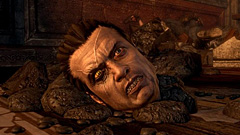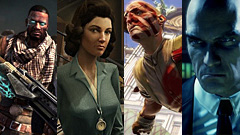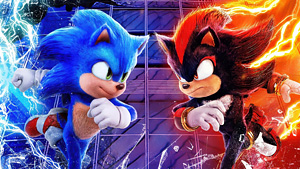February 10, 2012 by Paul Curtin


From the storytelling to the gameplay, summing up NeverDead as “strange” would be an understatement. NeverDead is filled with weird characters and even weirder gameplay concepts. The story revolves around a once prestigious demon hunter named Bryce Boltzmann who fails at slaying the demon king Astaroth and as a result loses his wife and the ability to die. After a brief intro explaining more details on how he’s been cursed with the demonic eye, the game jumps forward five hundred years to a now sarcastic anti-hero Bryce who spends the majority of his time hunting demons for cash, which he uses to drown his sorrows at a local dive bar when not passed out in his roach-infested apartment.
NeverDead’s story is interesting to say the least, but its gameplay is what sets it apart from anything you’ve ever played before. Since Bryce is immortal, he can’t die and has the ability to keep fighting after losing his arms, legs, and head. The game only ends when Bryce has been decapitated and his head is devoured by an enemy or an ally bleeds out after being downed. This makes the gameplay incredibly unique and diverse with tons of different types of enemies and bosses who will constantly rip off parts of Bryce as he continues to fight sans an arm or a leg or any limbs at all.
Surprisingly, unlike most games with a partner system, Bryce’s ally Arcadia does just enough to not play the game for you (Gears of War 3) and doesn’t get in the way to the point where you want to kill her instead of the monsters trying to kill you (Resident Evil 5). What’s most frustrating about NeverDead is the way in which Bryce loses his limbs a little too often and the manner in which players must rejoin said limbs one by one. The regeneration system is fairly simple: when Bryce loses a limb he has to roll back over it in order to put himself back together, unless he has his regen meter full, which allows him to instantly sprout whatever limbs he’s missing. Once he’s lost his head the player then controls just the head and must roll it around and reattach it to the rest of Bryce’s body, which can sometimes be difficult to achieve due to the controls and amount of enemies and debris laying around. There are times where Bryce will over jump body parts you’re trying to pick up and other times where his head will be an inch away from his neck and the game won’t register the connection, leading to his head being eaten by an enemy and resulting in a restart if the single-chance mini game is failed, which is easy to do if you suck at timed active reloads in games like Gears of War.
For the most part putting Mr. Brycehead back together isn’t a difficult task, but certain encounters like the final boss whose attack constantly causes Bryce to break apart without enough time for the player to fully put him back together can make a player lose their own head, especially when the AI voice over notification repeatedly screams “Bryce, look out!” twice as loud as characters talking in cutscenes with no way to adjust the levels. Thankfully, the game’s soundtrack is great and features bands like Megadeth, which you can crank up if you get tired of hearing your AI partner scream the same lines over and over again during intense parts of the game.

Despite the rage-inducing moments, the overall bodily dismemberment experience is pretty awesome, and there are moments that are especially funny like when you see demon dogs rip off Bryce’s arms and/or legs, leaving him to hop or crawl around while still being able to shoot both weapons even if both his arms are still detached and in the mouths of demons who are running away with them. There are even multiple puzzles and hidden collectable objects scattered throughout the game which require Bryce to use tricks like turning his body into a conductor by electrocuting himself to pass a current to an electrical unit without power, setting himself on fire to see in unlit areas, and pulling off and throwing his arm or head in order to get into smaller or higher areas. Everything about the way levels are designed fits perfectly with the system and makes for interesting experiences when trying to figure out how you’re going to solve a puzzle.
But NeverDead isn’t just a simple third-person user with a single gimmick; there are tons of impressive features like detailed level designs full of destructible environments and an upgrade system that when combined with the game’s solid dual-wielding system allows players far more freedom with how they take out enemies. The melee system is a bit of a repetitive slashfest, but not all enemies can simply be hacked to death, and shooting exploding barrels or taking out support beams and dropping ceilings onto enemies is always more fun and effective. There’s also a full upgrade system that allows Bryce to be fitted with an extensive list of unique abilities after collecting experience points from throughout each level.
The upgrade list features tons of abilities that make gameplay more fun and add to the campaign’s replayability as you go back and try new abilities, like different rude and cowardly dialog options from Bryce and increased stats to areas like gun power and health. Some abilities are definitely required for a better gaming experience; for example, playing without abilities like Sixth Sense (which slows down time when Bryce is about to take damage) and improved movement when crawling and head rolling is a bad idea that I’d highly recommend not going without as soon as they’re unlocked.

When everything comes together and works the gameplay is about as good as a game gets. Combining certain abilities into a playstyle can make for some of the most epic moments ever, like having Bryce set himself on fire in order to shoot flaming bullets all while dodging crazy obstacles the developers throw at you like cars on a bridge or trains in a subway. If you don’t get the Sixth Sense slow-motion option, you’re not playing the game right and missing out on a whole hell of a lot of fun.
In addition to the eight hour campaign, NeverDead features multiplayer challenges that let four people team up online and play through recognizable areas from the campaign and fight waves of enemies in escort missions. It’s another case of a game with an interesting singleplayer concept that could have been used to make a unique competitive multiplayer experience if done right, but instead made into a tacked-on co-op mode that serves no purpose besides poorly trying to justify the $59.99 you just spent. The co-op isn’t terrible; it’s just boring, meaningless, and laggy — that is if you can even find anybody online to play with.
With interesting characters and solid gameplay, NeverDead manages to deliver a fun and memorable third person shooter experience that doesn’t take itself too seriously and that you’ll always remember. Unfortunately, unlike the game’s lead protagonist, it seems like time wasn’t on the developers’ side and the game was released a bit too soon and could have used a little more polish and better online modes. While the campaign for the most part is enjoyable, the system of collecting limbs can be a pain in the ass that will turn off gamers who aren’t looking for a challenge. Hopefully the best ideas from NeverDead will live on in future games because there’s a ton of brilliant new ideas that just didn’t play out as well as they could have. NeverDead gets 3.5 out of 5 stars (Very Good).
The Pros
- Unique gameplay mechanics never seen before in gaming
- One of the best uses of slow motion and destructible environments ever
- Solid aiming mechanics with a great dual-wielding system
- Interesting story with memorable characters
- Good music and visuals that never lag in the midst of action-packed moments
The Cons
- Controls when putting Bryce back together can be frustrating
- Melee system is too repetitive
- Rage-inducing, poorly designed final boss
- Online co-op is lame and has lag issues














